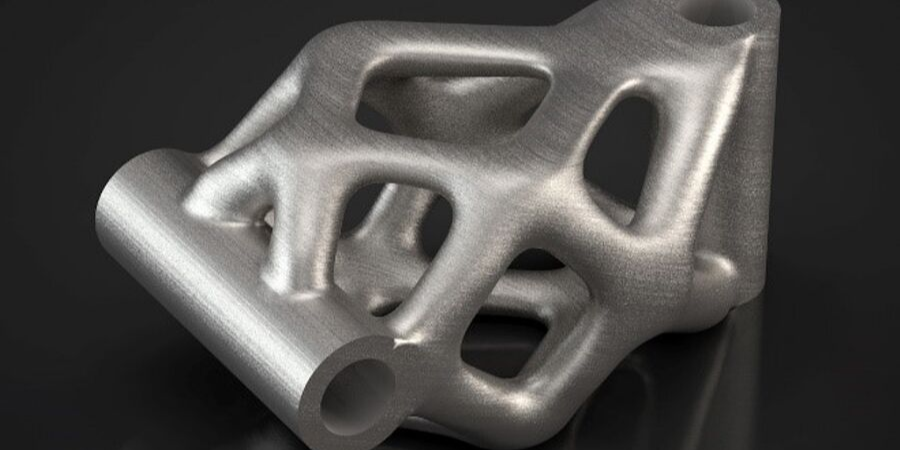Cat McClintock contributes to the Creo and Mathcad blogs for PTC. She has been a writer and editor for 15+ years, working for CAD, PDM, ERP, and CRM software companies. Prior to that, she edited science journals for an academic publisher and aligned optical assemblies for a medical device manufacturer. She holds degrees in Technical Journalism, Classics, and Electro-Optics. She loves talking to PTC customers and learning about the interesting work they're doing and the innovative ways they use the software.
Additive manufacturing (AM) might be nearly four decades old (yes, really), but real-world applications have only taken off in the last decade or so. If you’re exploring this game-changing technology, read this quick primer on what it is and why it matters.
What Is Additive Manufacturing?
Additive manufacturing simply describes a method of building objects layer by layer. You design a 3D model, generally in a CAD program, and send the data to a machine (sometimes called a 3D printer) that then creates a physical object. (Check out this post for a more in-depth definition of additive manufacturing.)
It can use a range of materials and techniques. For example, it can involve simple extrusion (imagine plastic layers applied like glue from a hot gun), material jetting (like an inkjet printer), or fine powders melted with lasers.
In fact, AM is so flexible, you can find it used today for both nanotechnology as well as for building houses. Here’s why everybody is so excited about it:
Additive Manufacturing Is Rewriting the Rules for Production
One of the striking advantages of additive manufacturing is that it’s self-contained. That is, it not only prints your object, it can also create the scaffolding to support the object during production. When the job is completed, post production might be as simple as snapping off the excess supports or blowing off loose powder.
Compare that to traditional manufacturing which may require weeks of setup, mold design, and tooling before the first part rolls off the production line.
For this very reason, additive manufacturing has proved popular with inventors and engineers, especially during prototyping. Once you have a design, you can create the physical part within hours. Even if you don’t have your own machinery, you can send a 3D CAD model to an agency and, within a day or two, have a physical part shipped back to you.
Additive Manufacturing Removes Limits on Design
Another shining characteristic of additive manufacturing is its ability to create parts that might not be possible with traditional manufacturing methods.
For example, a lattice structure can help you create an object that is lighter and uses less material than a solid. Traditional production methods like casting and milling aren’t well suited to produce those intricate lattices. Parts may not exit molds cleanly. And milling costs skyrocket when you remove material from multiple directions.

The lattice structures in this design will save material and weight but wouldn’t be economical to produce with traditional manufacturing methods.
Additive manufacturing, on the other hand, doesn’t impose those same limits. There are no molds or concerns about cutting tools reaching into tiny crannies. As such, you need not worry about how the machinery will handle every beam, node, and cell.
AM works well with artificial intelligence, too. For example, generative design is an AI technology that suggests designs based on the requirements you specify. Often unconventional in appearance, AM can easily handle even the most organic AI shapes.

A part designed for additive manufacturing. While generative design can work with traditional manufacturing methods, additive often offers the most design flexibility.
The Available Materials Seem Infinite
Until recently, AM materials tended to use plastic, but that’s quickly changing. “The number of materials that AM can handle is constantly expanding,” say the business analysts at McKinsey. “A wide range of new plastics has been developed, along with processes and machines for printing with ceramics, glass, paper, wood, cement, graphene, and even living cells.” Dozens of metals have become available recently, too.
Meanwhile, researchers at places like MIT and Washington State are innovating new ways to mix materials into a single build, thus creating objects with properties not possible with a single substance. As more and varied materials emerge, additive manufacturing promises to become even more vital to product development in the near future.
Will Additive Manufacturing Scale?
As noted earlier, companies often prefer additive manufacturing for prototyping and low-volume production. Just send the 3D CAD model to a machine, and a few hours later, you hold the physical part in your hand.
Of course, “a few hours later” isn’t acceptable when you have orders for hundreds of thousands of units due in a few weeks. That’s why most companies haven’t seriously considered AM for mass production. However, that’s quickly changing. Vendors are catching up, offering faster and more efficient ways to produce parts every year.
In fact, a few companies are already successfully using AM en masse. Chanel, for example, says it will soon produce a million mascara brushes a month using AM. German automaker BMW now 3D prints essential parts for its i8 roadster. While Adidas produces its Futurecraft 4D sneaker midsole via 3D printing mass production.
Additive Manufacturing Spurs Innovation
Why is additive manufacturing important? It is pushing design engineers to approach problems in new ways. No longer constrained by the old rules for manufacturing and materials, engineers can now explore their own imaginations to find new solutions. That is leading to more competitive designs, more novel use of materials, and better innovation overall.
